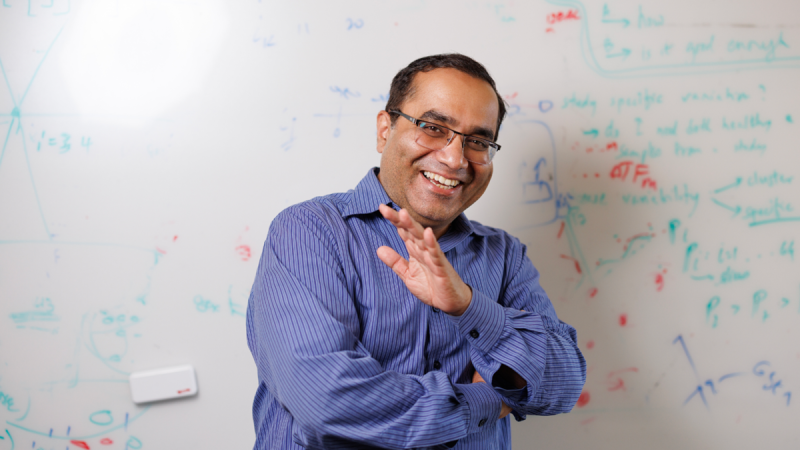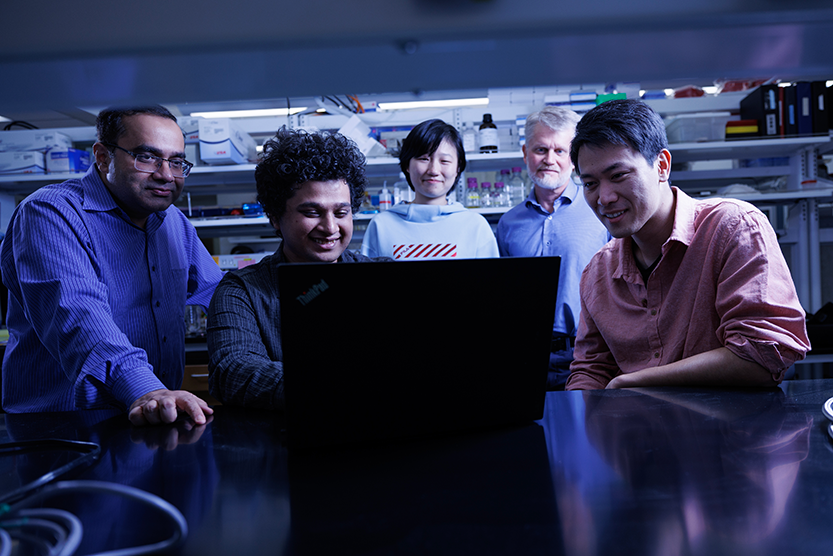
Honey, I Shrunk the Proteins
In August 2024, Duke University School of Medicine computational biologist Rohit Singh, PhD, posted on the social media platform X, “Introducing Raygun, a new approach to protein design.”
He was talking about an artificial intelligence tool his team created to help biologists “shrink” or “expand” existing proteins. The X post got nearly 200,000 views and nearly 1,000 likes. He also posted a link to a draft paper on bioRxiv, a “preprint” website where scientists share work ahead of formal publication.
Across the country, at University of California San Diego, biophysics PhD student Young Su Ko was intrigued. He doesn’t usually have time to try out any of the “cool projects” he reads about. But this one was different. “Rohit is a big guy in the field. I was a fan of his research,” Ko said.
Ko decided to use Raygun to compete in a protein design competition. To his surprise, the tool helped him design two new proteins that may show promise as chemotherapies, and he won top 10 placement in the contest.
Raygun is just one of several tools that Singh, an assistant professor of biostatistics & bioinformatics and cell biology, has built to help scientists work both faster and smarter to understand disease and ultimately develop better therapies. Most of them he makes widely available for further development.
Singh isn’t allergic to making money, having previously applied AI to the financial world, including founding a startup company that used deep learning to help small businesses assess risk and get credit. He has worked with Duke’s Office of Translation and Commercialization to file a provisional patent on CoNCISE, a tool that can scan a catalog of billions of chemical compounds in seconds. And for commercial uses of RayGun, he would aim to patent that too.
But he sees value in making tools accessible to other scientists early on. “You need to make it easy for people to build on top of it and try things out,” he said. “Science is better for sharing.”
Translating the Language of Proteins
While other computational biologists (including 2024 Nobel Prize winner David Baker, PhD, of the University of Washington) have created tools that can design an entirely new protein from scratch, Singh’s team developed Raygun to improve upon existing proteins by adding or deleting amino acids. That is, by “shrinking” or “enlarging” them.

Singh and postdoctoral fellow Kapil Devkota, PhD, named it Raygun in homage to movies like “Honey I Shrunk the Kids,” in which a scientist invents a “shrinkray” that blasts a laser to miniaturize objects. “Kapil and I and the other co-authors are all sci-fi fans, and there is this trope of a laser gun that can shrink or expand things,” Singh said. “And we thought, wouldn’t it be cool to have something like that in real life.”
Unlike its movie counterpart, Raygun isn’t a contraption that uses lasers; it’s a machine- learning framework (a computer program that runs two different algorithms).
Raygun is based on protein language models, which work on the same principle as large language models, which are the basis of chatbots that many people use every day. There is a “language” that governs how a protein’s amino acid sequence leads to its shape and function, Singh said, but scientists don’t fully understand it. Protein language models analyze patterns between sequence and function in millions of proteins, acting as a “translator,” Singh said.
“The catch here is that the translation gets more and more unreliable the further you get from the original protein,” he said. “But in some cases, we can actually shrink a protein by 50% while keeping the overall behavior the same.”
Better Sensors
A case in point: Singh’s team used Raygun to “shrink” two proteins that are commonly used as fluorescent reporters (eGFP and mCherry). Then Scott Soderling, PhD, professor and chair of cell biology at Duke, had the DNA encoding the redesigned proteins synthesized by a company, then conducted cell-based imaging experiments with the proteins to show that they still maintained their fluorescent properties.
This shows that Raygun may be useful for creating more accurate biological sensors. “So much of biology is about imaging now,” Singh said.

Scientists will fuse a protein with fluorescent properties onto a particular gene or protein of interest so that the protein will glow when it’s expressed. But that very process can cause unintended changes.
“It’s actually pretty risky in terms of being able to measure what you want to measure,” Singh said. “It’s like you have a car that gives you 30 miles to the gallon, and then you attach a big trailer to it, and then your whole mileage is off. You want the trailer to be as aerodynamic as possible.”
Singh, Devkota, and team are computer scientists, so they spend much of their time “writing tons and tons of code.” But they do this tucked outside a cell biology wet lab on the fourth floor of the Sands basic sciences building, embedded with the scientists who can benefit from their tools.
In this model for “discovery AI” at Duke, the computer scientists are “a vital part of the ecosystem of basic science in which biologists and computer scientists work together,” Soderling said.
A Surprising Success
Raygun is good at enlarging proteins, too, as Ko’s success in the protein design competition showed. Contestants were asked to design new proteins that would be relevant to chemotherapy, specifically proteins that would bind to epidermal growth factor receptor, (EGFR) which is involved in several types of cancers, including breast cancer.

Ko instructed Raygun to enlarge the protein epidermal growth factor but still preserve its function. “My thought was if we can miniaturize an existing binder or enlarge an existing binder to the EGFR, maybe that can improve the binding in some way,” he said.
To use Raygun, all Ko needed was the preprint, as well as the computer code and files that Singh had posted on file-sharing site GitHub.
“They basically shared the recipe for how you use Raygun,” Ko said.
The program suggested 10 candidate proteins that Ko submitted to the contest. Entries were narrowed down using computer analysis, and for the top 200 entries, scientists in a wet lab synthesized and tested the new proteins.
Four of Ko’s candidate proteins made it to the wet-lab step. In experimental testing, two of them bound to the epidermal growth factor receptor. “Fifty percent is a pretty high success rate for designing and making a protein that actually binds to the desired structure. That was already very exciting,” Ko said.
One of those two proteins bound better to EGFR than EGF itself. This result won Ko his top 10 placement.
Surprisingly, the new protein that bound most tightly to EFGR was the one that was the least like the original protein. So, these modifications would not have been obvious to a scientist. “The Raygun model has a deeper understanding of which amino acids can be changed to actually improve the binding,” Ko said.
Ko posted about the win on X, but he never expected Singh to see it. “I have less than 100 followers,” he said.
But Singh did see it, and he reached out to Ko. They’re now collaborating, adding Ko’s results to a paper the team has submitted for journal publication, with Devkota as first author. Ko and Devkota met up to talk science when he visited San Diego for a conference.
“It's one of those cool things,” Singh said. “We built something that we think of as a fundamental innovation, then people took it in directions we didn’t imagine.”
Angela Spivey is a science writer and managing editor in the Office of Strategic Communications at Duke University School of Medicine.
Photos by Eamon Queeney, assistant director of multimedia and creative in the Office of Strategic Communications.
